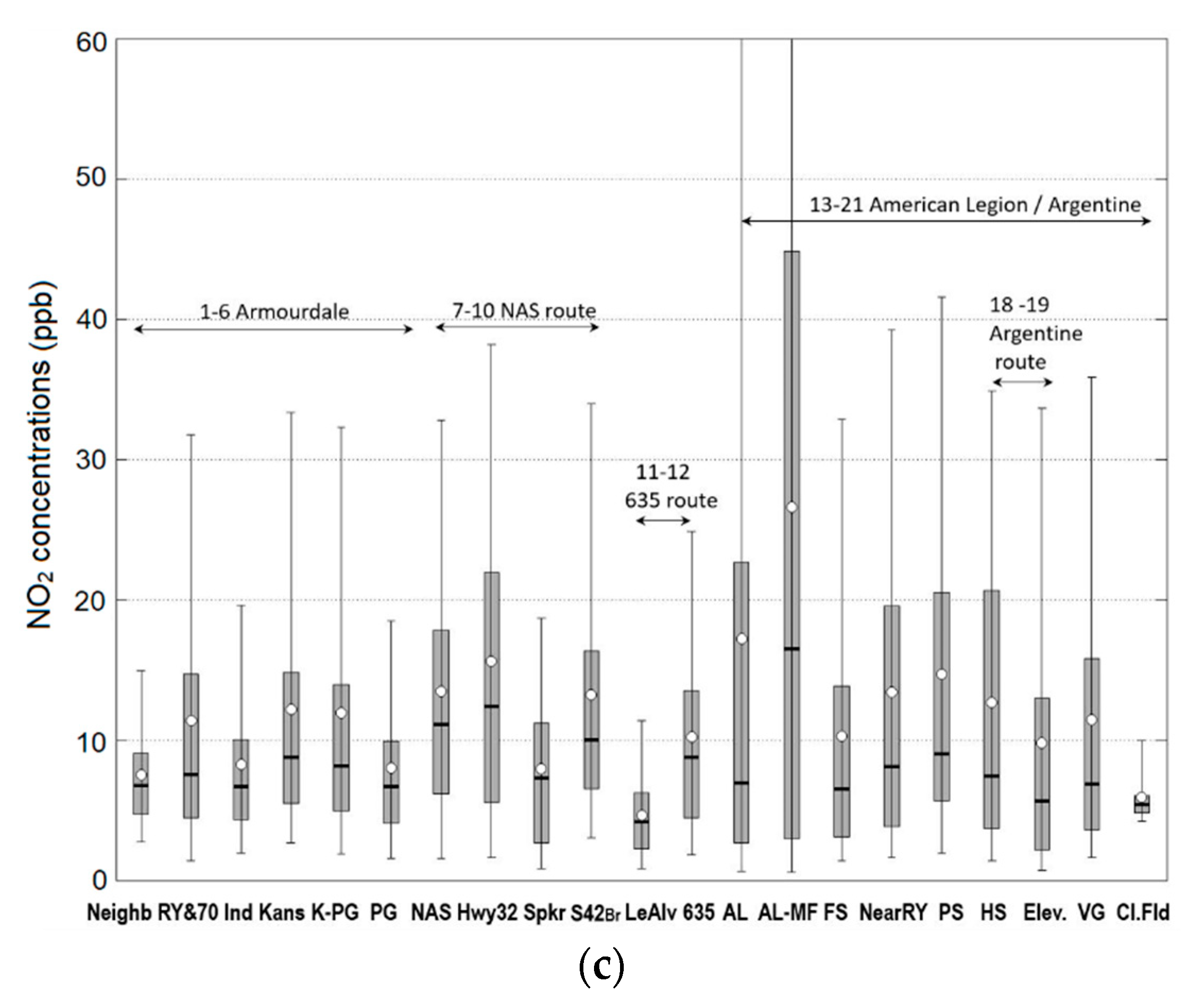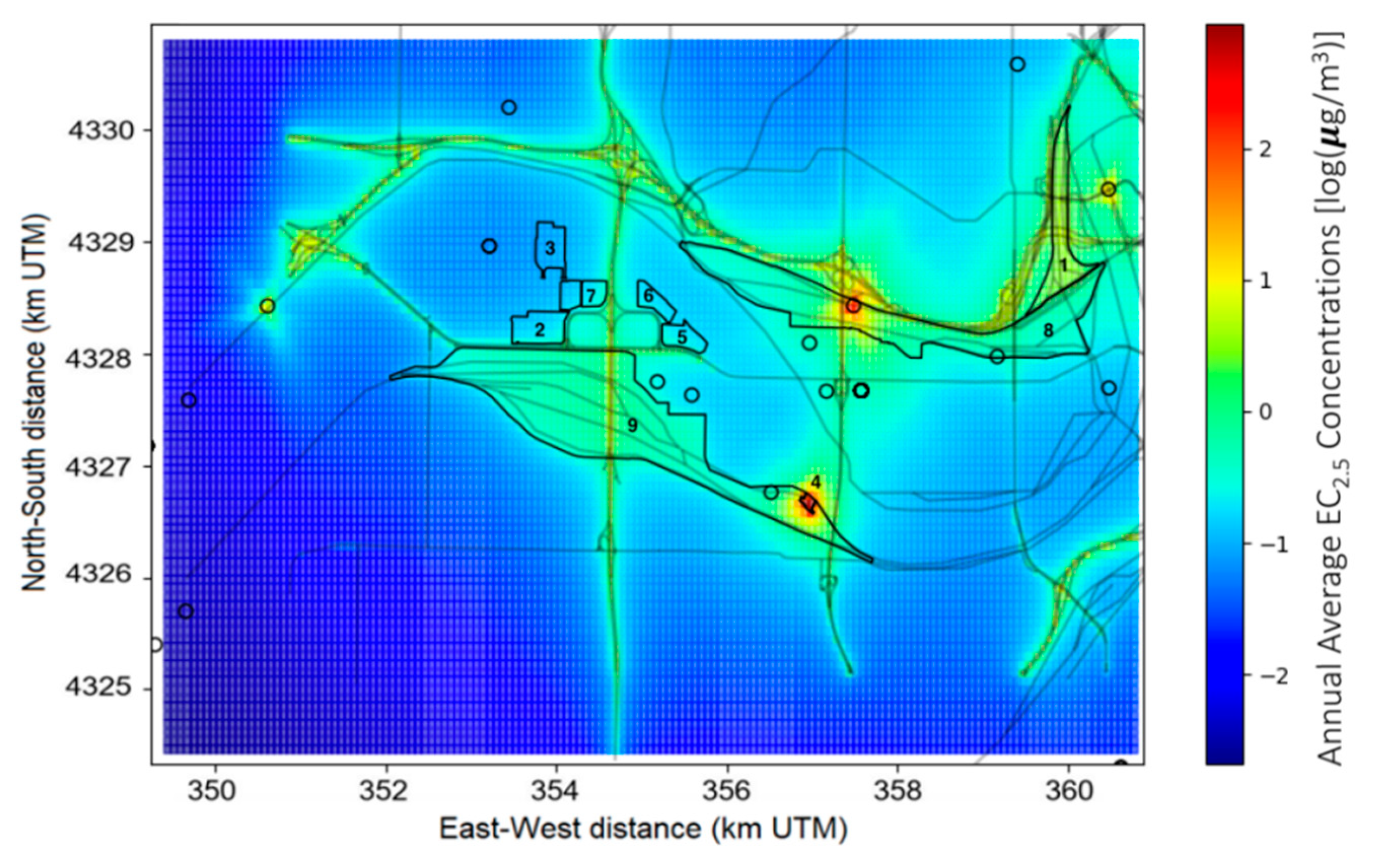Combining Dispersion Modeling and Monitoring Data for Community-Scale Air Quality Characterization
Abstract
:1. Introduction
2. Methods
2.1. KC-TRAQS Field Study
2.2. Dispersion Modeling to Support Field Study Design
2.3. Dispersion Modeling to Support the Analysis
2.4. Data Fusion
3. Results
3.1. Combining Stationary and Mobile Monitoring Data
3.2. Combining Dispersion Modeling to Estimate Relative Contribution of Air Pollution Sources
3.3. Application of a Data Fusion Method Using Dispersion Modeling and Observations
4. Summary and Conclusions
Author Contributions
Funding
Acknowledgments
Conflicts of Interest
References
- HEI. 2010: Traffic-Related Air Pollution: A Critical Review of the Literature on Emissions, Exposure, and Health Effects; Special Report 17; Health Effects Institute: Boston, MA, USA, 2010; Available online: https://www.healtheffects.org/system/files/SR17Traffic%20Review.pdf (accessed on 24 June 2019).
- Rosenbaum, A.; Hartley, S.; Holder, C. Analysis of diesel particulate matter health risk disparities in selected US harbor areas. Am. J. Public Health 2011, 101, S217–S223. [Google Scholar] [CrossRef] [PubMed]
- Baldauf, R.W.; Heist, D.; Isakov, V.; Perry, S.; Hagler, G.S.W.; Kimbrough, S.; Shores, R.; Black, K.; Brixey, L. Air quality variability near a highway in a complex urban environment. Atmos. Environ. 2013, 64, 169–178. [Google Scholar] [CrossRef]
- Arunachalam, S.; Brantley, H.; Barzyk, T.; Hagler, G.; Isakov, V.; Kimbrough, S.; Naess, B.; Rice, N.; Snyder, M.; Talgo, K.; et al. Assessment of port-related air quality impacts: Geographic analysis of population. Int. J. Environ. Pollut. 2015, 58, 231–250. [Google Scholar] [CrossRef]
- Kelly, J.; Baker, K.; Napelenok, S.; Roselle, S. Examining single-source secondary impacts estimated from brute-force, decoupled direct method, and advanced plume treatment approaches. Atmos. Environ. 2015, 111, 10–19. [Google Scholar] [CrossRef]
- Hofman, J.; Lefebvre, W.; Janssen, S.; Nackaerts, S.; Nuyts, S.; Mattheyses, L.; Samson, R. Increasing the spatial resolution of air quality assessments in urban areas: A comparison of biomagnetic monitoring and urban scale modelling. Atmos. Environ. 2014, 92, 130–140. [Google Scholar] [CrossRef]
- Borrego, C.; Amorim, J.; Tchepel, O.; Dias, D.; Rafael, S.; Sá, E.; Pimentel, C.; Fonte, T.; Fernandes, P.; Pereira, S.; et al. Urban scale air quality modelling using detailed traffic emissions estimates. Atmos. Environ. 2016, 131, 341–351. [Google Scholar] [CrossRef] [Green Version]
- Brantley, H.; Hagler, G.; Herndon, S.; Massoli, P.; Bergin, M.; Russell, A. Characterization of Spatial Air Pollution Patterns Near a Large Railyard Area in Atlanta, Georgia. Int. J. Environ. Res. Public Health 2019, 16, 535. [Google Scholar] [CrossRef] [PubMed]
- Sorte, S.; Arunachalam, S.; Naess, B.; Seppanen, C.; Rodrigues, V.; Valencia, A.; Borrego, C.; Monteiro, A. Assessment of source contribution to air quality in an urban area close to a harbor: Case-study in Porto, Portugal. Sci. Total Environ. 2019, 662, 347–360. [Google Scholar] [CrossRef] [PubMed]
- Cook, R.; Isakov, V.; Touma, J.; Benjey, W.; Thurman, J.; Kinnee, E.; Ensley, D. Resolving Local-Scale Emissions for Modeling Air Quality near Roadways. J. Air Waste Manag. Assoc. 2008, 58, 451–461. [Google Scholar] [CrossRef] [PubMed] [Green Version]
- Lefebvre, W.; Degrawe, B.; Beckx, C.; Vanhulsel, M.; Kochan, B.; Bellemans, T.; Janssens, D.; Wets, G.; Janssen, S.; De Vlieger, I.; et al. Presentation and evaluation of an integrated model chain to respond to traffic- and health-related policy questions. Environ. Model. Softw. 2013, 40, 160–170. [Google Scholar] [CrossRef]
- Thoma, E.; George, I.; Duvall, R.; Wu, T.; Whitaker, D.; Oliver, K.; Mukerjee, S.; Brantley, H.; Spann, J.; Bell, T.; et al. Rubbertown Next Generation Emissions Measurement Demonstration Project. Int. J. Environ. Res. Public Health 2019, 16, 2041. [Google Scholar] [CrossRef] [PubMed]
- Kimbrough, S.; Krabbe, S.; Baldauf, R.; Barzyk, T.; Brown, M.; Brown, S.; Croghan, C.; Davis, M.; Deshmukh, P.; Duvall, R.; et al. The Kansas City Transportation and Local-Scale Air Quality Study (KC-TRAQS): Integration of Low-Cost Sensors and Reference Grade Monitoring in a Complex Metropolitan Area. Chemosensors 2019, 7, 26. [Google Scholar] [CrossRef]
- Deshmukh, P.; Isakov, V.; Venkatram, A.; Yang, B.; Zhang, K.M.; Logan, R.; Baldauf, R. The effects of roadside vegetation characteristics on local, near-road air quality. Air Qual. Atmos. Health 2019, 12, 259–270. [Google Scholar] [CrossRef]
- Isakov, V.; Barzyk, T.; Smith, E.; Arunachalam, S.; Naess, B.; Venkatram, A. A Web-based Modeling System for Near-Port Air Quality Assessments. Environ. Model. Softw. 2017, 98, 21–34. [Google Scholar] [CrossRef] [PubMed]
- Chang, S.Y.; Vizuete, W.; Valencia, A.; Naess, B.; Isakov, V.; Palma, T.; Breen, M.; Arunachalam, S. A modeling framework for characterizing near-road air pollutant concentration at community scales. Sci. Total Environ. 2015, 538, 905–921. [Google Scholar] [CrossRef] [PubMed]
- Cimorelli, A.J.; Perry, S.G.; Venkatram, A.; Weil, J.C.; Paine, R.J.; Wilson, R.B.; Lee, R.F.; Peters, W.D.; Brode, R.W. AERMOD: A dispersion model for industrial source applications. Part I: General model formulation and boundary layer characterization. J. Appl. Meteorol. 2005, 44, 682–693. [Google Scholar] [CrossRef]
- Venkatram, A.; Horst, T.W. Approximating dispersion from a finite line source. Atmos. Environ. 2006, 40, 2401–2408. [Google Scholar] [CrossRef]
- Snyder, M.G.; Venkatram, A.; Heist, D.K.; Perry, S.G.; Petersen, W.B.; Isakov, V. R-LINE: A Line Source Dispersion Model for Near-Surface Releases. Atmos. Environ. 2013, 77, 748–756. [Google Scholar] [CrossRef]
- Barzyk, T.; Isakov, V.; Arunachalam, S.; Venkatram, A.; Cook, R.; Naess, B. A Near-Road Modeling System for Community-Scale Assessments of Traffic-Related Air Pollution in the United States. Environ. Model. Softw. 2015, 66, 46–56. [Google Scholar] [CrossRef]
- U.S. Environmental Protection Agency (EPA). 2014 National Emissions Inventory (NEI) Data. Available online: https://www.epa.gov/air-emissions-inventories/2014-national-emissions-inventory-nei-data (accessed on 27 August 2019).
- Institute for the Environment—The University of North Carolina at Chapel Hill. SMOKE v3.6.5 User’s Manual. Available online: https://www.cmascenter.org/smoke/documentation/3.6.5/html/ (accessed on 1 October 2019).
- Houyoux, M.; Vukovich, J.; Coats, C.; Wheeler, N.; Kasibhalta, P. Emission inventory development and processing for the Seasonal Model for Regional Air Quality (CMRAQ) project. J. Geophisical Res. 2000, 105, 9079–9090. [Google Scholar] [CrossRef]
- E2 Managetech. Argentine Yard Emission Inventory; Technical Report for BNSF Railway Company; E2 Managetech: Long Beach, CA, USA, 2015. [Google Scholar]
- Baker, M. Quantification of Pennsylvania Heavy-Duty Diesel Vehicle Idling and Emissions; Technical Report for the Pennsylvania Dept. of Environmental Protection; M. Baker Inc.: Linthicum, MD, USA, 2007. [Google Scholar]
- National Drought Mitigation Center: Annual Climatology for Kansas City, MO. Available online: https://drought.unl.edu/archive/climographs/KansasCityANC.htm (accessed on 1 October 2019).
- Hagler, G.S.W.; Solomon, P.A.; Hunt, S.W. New Technology for Low-Cost, Real-Time Air Monitoring; Air & Waste Management Association: Pittsburgh, PA, USA, 2014. [Google Scholar]
- Castell, N.; Dauge, F.R.; Schneider, P.; Vogt, M.; Lerner, U.; Fishbain, B.; Broday, D.; Bartonova, A. Can commercial low-cost sensor platforms contribute to air quality monitoring and exposure estimates? Environ. Int. 2017, 99, 293–302. [Google Scholar] [CrossRef] [PubMed]
- Yi, W.Y.; Lo, K.M.; Mak, T.; Leung, K.S.; Leung, Y.; Meng, M.L. A survey of wireless sensor network based air pollution monitoring systems. Sensors 2015, 15, 31392–31427. [Google Scholar] [CrossRef] [PubMed]
- Reyes, J.; Xu, Y.; Vizuatte, W.; Serre, M. Regionalized PM2.5 Community Multiscale Air Quality model performance evaluation across a continuous spatiotemporal domain. Atmos. Environ. 2016, 148, 258–265. [Google Scholar] [CrossRef] [PubMed]
- Xu, Y.; Serre, M.L.; Reyes, J.M.; Vizuete, W. Bayesian Maximum Entropy integration of ozone observations and model predictions: A national application. Environ. Sci. Technol. 2016, 50, 4393–4400. [Google Scholar] [CrossRef] [PubMed]
- Serre, M.L.; Christakos, G. Modern geostatistics: Computational BME analysis in the light of uncertain physical knowledge—The Equus Beds study. Stoch. Environ. Res. Risk Assess. 1999, 13, 1–26. [Google Scholar] [CrossRef]
- Christakos, G.; Serre, M.L. BME analysis of spatiotemporal particulate matter distributions in North Carolina. Atmos. Environ. 2000, 34, 3393–3406. [Google Scholar] [CrossRef]
- Ahangar, F.; Freedman, F.; Venkatram, A. Using Low-Cost Air Quality Sensor Networks to Improve the Spatial and Temporal Resolution of Concentration Maps. Int. J. Environ. Res. Public Health 2019, 16, 1252. [Google Scholar] [CrossRef] [PubMed]
- Schneider, P.; Castell, N.; Vogt, M.; Dauge, F.R.; Lahoz, W.A.; Bartonova, A. Mapping urban air quality in near real-time using observations from low-cost sensors and model information. Environ. Int. 2017, 106, 234–247. [Google Scholar] [CrossRef] [PubMed]
- BMElib. Available online: https://mserre.sph.unc.edu/BMElab_web/ (accessed on 8 August 2019).
- Emery, C.; Liu, Z.; Russell, A.; Odman, T.; Yarwood, G.; Kumar, N. Recommendations on statistics and benchmarks to assess photochemical model performance. J. Air Waste Manag. Assoc. 2017, 67, 582–598. [Google Scholar] [CrossRef] [PubMed] [Green Version]









| Pollutant | Emissions from NEI-2014-v2 1 | MF Fraction % | MF Contribution | Railyard Contribution |
|---|---|---|---|---|
| NOx | 158.218 | 44% | 69.616 | 88.602 |
| PM2.5 | 3.921 | 49% | 1.921 | 2.000 |
| EC2.5 | 3.024 | 49% | 1.482 | 1.542 |
| n 1 | Area Source Name | NOx | PM2.5 | EC2.5 |
|---|---|---|---|---|
| 1 | Armstrong | 39.899 | 1.089 | 0.840 |
| 2 | Associated Wholesale Grocers | 1.061 | 0.0052 | 0.0012 |
| 3 | USPS Distribution Center | 0.384 | 0.0052 | 0.032 |
| 4 | BNSF Maintenance Facility | 69.616 | 1.921 | 1.482 |
| 5 | UPS Freight | 0.164 | 0.0022 | 0.0005 |
| 6 | Sam’s Club Distribution | 0.125 | 0.0017 | 0.0004 |
| 7 | Estes Express Lines | 0.068 | 0.0009 | 0.0002 |
| 8 | Union Pacific Armourdale Yard | 22.277 | 0.606 | 0.467 |
| 9 | Santa Fe Argentine Yard | 88.602 | 2.000 | 1.542 |
| Statistical Measure | Dispersion Modeling | Data Fusion |
|---|---|---|
| MB | −0.415 | −0.006 |
| ME | 0.433 | 0.282 |
| RMSE | 0.517 | 0.358 |
| NMB | −52.9 | −1.41 |
© 2019 by the authors. Licensee MDPI, Basel, Switzerland. This article is an open access article distributed under the terms and conditions of the Creative Commons Attribution (CC BY) license (http://creativecommons.org/licenses/by/4.0/).
Share and Cite
Isakov, V.; Arunachalam, S.; Baldauf, R.; Breen, M.; Deshmukh, P.; Hawkins, A.; Kimbrough, S.; Krabbe, S.; Naess, B.; Serre, M.; et al. Combining Dispersion Modeling and Monitoring Data for Community-Scale Air Quality Characterization. Atmosphere 2019, 10, 610. https://doi.org/10.3390/atmos10100610
Isakov V, Arunachalam S, Baldauf R, Breen M, Deshmukh P, Hawkins A, Kimbrough S, Krabbe S, Naess B, Serre M, et al. Combining Dispersion Modeling and Monitoring Data for Community-Scale Air Quality Characterization. Atmosphere. 2019; 10(10):610. https://doi.org/10.3390/atmos10100610
Chicago/Turabian StyleIsakov, Vlad, Saravanan Arunachalam, Richard Baldauf, Michael Breen, Parikshit Deshmukh, Andy Hawkins, Sue Kimbrough, Stephen Krabbe, Brian Naess, Marc Serre, and et al. 2019. "Combining Dispersion Modeling and Monitoring Data for Community-Scale Air Quality Characterization" Atmosphere 10, no. 10: 610. https://doi.org/10.3390/atmos10100610






